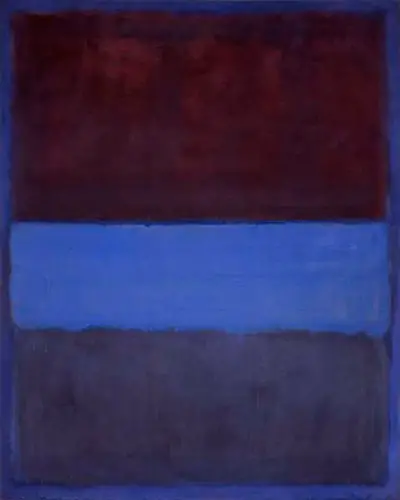The artist would use the term 'inner light' to describe his approach to colour within his abstract paintings. There was a careful consideration around the rectangles within his pieces, as well as the combination of tones that went into each iteration. Those new to his work would perhaps not understand this straight away. His intention was for us to feel the painting all around us, which takes time and energy from the viewer - a simple, quick browse of his work would not generally get the feeling that he was attempting to create. It is hard to tell from the image featured here, but No. 61 (Rust and Blue) from 1953 actually features multiple layers of oils which served to add a luminous effect to the key parts of the composition. As different as it may appear to traditional art, some academics have actually drawn comparisons with the work of Titian, and specifically his painting titled Noli me tangere, from 1514, which also used a similar technique of layering paint for a rich finish.
An element to Rothko's style within his colour field paintings that only those who see them in person will understand is the amount of variety of techniques that he used within them. Simple photographs of his major works like Untitled (1952) and Orange and Yellow will simply not convey the layering, luminosity and also the correct orientation which may not be quote as it first appears. He would work with large rectangles of colour, in this case shades of rust and various blue tones, and then blur around the edges to section of the different regions of the composition. You will find similar within most of his other paintings during this stage of his career and he would develop and tweak his approach over time.
This painting is believed to have first been exhibited at the Museum of Modern Art in 1961, although there is some evidence that it was included in a smaller venue (possibly the Janis Gallery, New York) in 1955, under the original title of simply, Rust and Blue. It has since been featured in exhibitions right across the world, including Rome, Zurich and London, but mostly within the city of Los Angeles. It is sized at 92cm wide by 115cm tall and it is listed as being entirely of oil on canvas, though it is possible that the artist used elements of egg in his work, similar to how Renaissance artists would produce frescoes many centuries ago. On the painting's reverse it is signed and dated by the artist in the top right corner. It has also sometimes been known as Brown, Blue, Brown on Blue.
This enjoyable version of Rothko's colour field series can be found in the collection of the Museum of Contemporary Art, Los Angeles and will normally be on display, but check ahead if you are specifically visiting in order to see No. 61 (Rust and Blue) in person. The global fame achieved by this artist has ensured that his work is now distributed right across the world, in a variety of private collections and public institutions. Naturally, his native US still hold the majority of his work but there has been a growing interest outside of the traditional markets of North America and Europe which has increased the valuations of his paintings considerably. For example, White Center (Yellow, Pink and Lavender on Rose) was sold for over $70m to the royal family of Qatar.
Latvian-born Mark Rothko would become one of the most famous artists in the history of American art and was integral in the development of new ideas and innovations within the 20th century. His oeuvre was much more varied than most realise, as much of his earlier paintings were in a variety of styles as he sought to find his own preferred way of working. Most exhibitions only tend to focus on his abstract fields of colour, and so that is how most of the public know him best. In fact, many of the best American artists were immigrants of first or second generation, underlining the opportunities that existed for those new to the country in the mid to late 20th century.
Visitors to the Museum of Contemporary Art in Los Angeles, US will have plenty to more to enjoy at this venue, besides just their collection of Rothko paintings. They focus on European and American art from post-1940 and feature the likes of Roy Lichtenstein, Barnett Newman, Jackson Pollock, Piet Mondrian and Arshile Gorky. They continue to expand their collection through generations donations from local collectors as well as the occasional direct acquisition. 20th century art is now proving exceptionally popular with younger generations and exhibitions of work from these types of artists tend to draw crowds that would otherwise not be interested in more traditional art. In a way, contemporary art can be an excellent way of introducing new people into art history, and then some will find a passion to learn more about all that came before, much of which would have inspired these contemporary artists in the first place.

